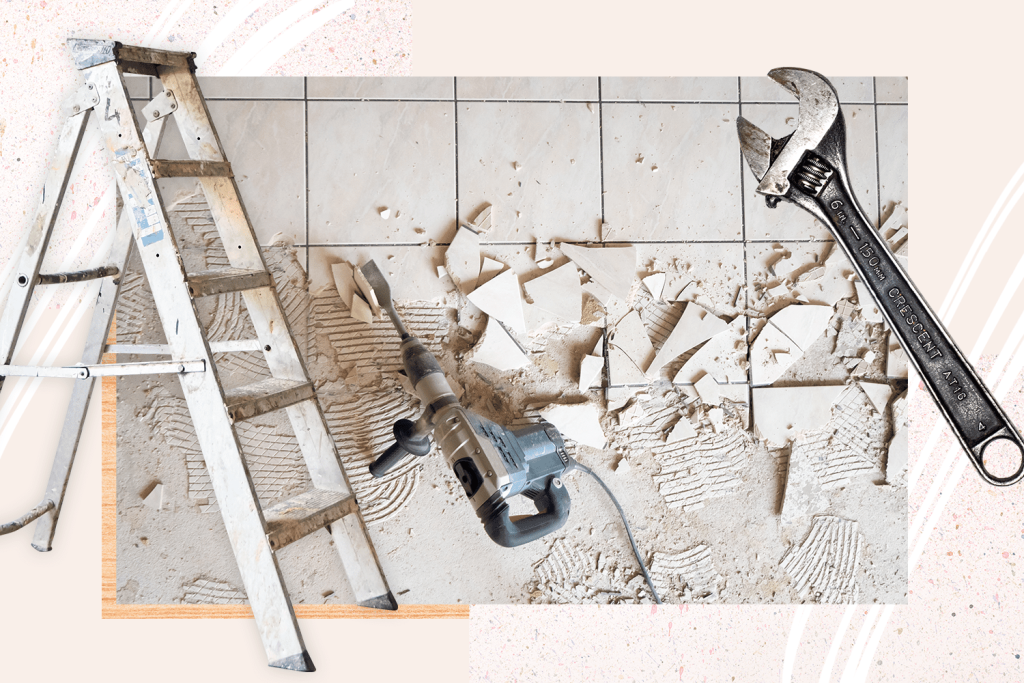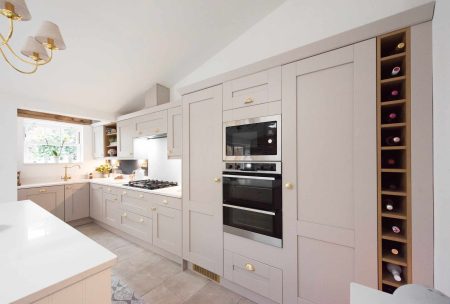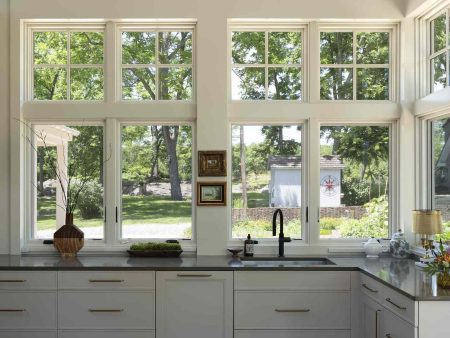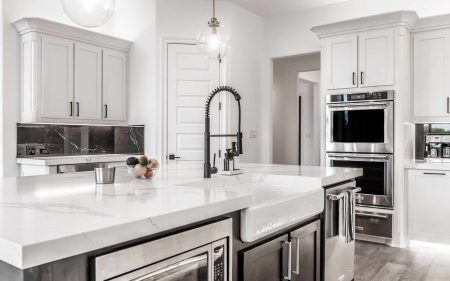When managing a renovation, whether it’s for a whole house or just a room, the best way to stay organized is with a home renovation checklist. Following a process and giving each step its due diligence is what helps a home renovation come in as close to your budget and on time as possible. We spoke to home renovation experts to get their top tips on planning, coordinating, and executing a renovation worth celebrating.
Set Intentions and Budget
The start of any home renovation requires a bird’s eye view of the entire process. Make sure you answer the following two questions: What you want to be changed, and how much money you want to spend to do it?
Figure Out What You Want and Why
Before you even start pulling inspiration, you have to know why you want to renovate. There are endless reasons you could want to overhaul a space — to increase a home’s value, modernize the space, change the style, better meet your family’s needs. Having a motivation in mind when you begin, one that you can share with any experts that you hire, will help you get what you want.
Set Priorities
Decide what’s most important to you. Which rooms do you want to renovate most? Do you care about sustainable design and construction, the longevity of a style, or do you want to be able to age in place? What are you not willing to sacrifice? If you want to increase natural light, windows are the priority. To maximize the functionality of your kitchen, put layout and appliances top of mind.
Set Your Budget
This is one of the trickiest but most crucial steps. Come up with your number, then tack 10 to 15% onto that, and that’s likely what you’ll spend. Don’t forget to include the cost of an interior designer or plan designer into your budget, and the cost of alternative housing if you’re looking to move out during the reno process.
Hire a Designer
It never hurts to hire a designer right from the start if you’re interested in using one.
“If you want your home to evoke a certain feeling, hire a designer,” explains designer Michelle Gage, founder and creative director at Michelle Gage Interiors. “[Designers] consider what your dining room will feel like when you host family, what your home office needs to ensure your ultimate productivity, and what will be in your line of sight when you walk through your front door.”
Designers could have their own build firms, which would handle hiring contractors and managing the renovation, or they could just assist in creating design plans. Regardless of their level of involvement, they’ll likely stay on for the duration of the project.
“It helps to have a partner through the renovation that’s been through it before,” explains designer Cortney McClure, lead designer and owner of Cortney McClure Design. “You can avoid mistakes that could be costly down the road.”
Make Design Plans
For many homeowners, designing your dream space is the most exciting part of the process. If you are working with a designer, they will go through this process with you, presenting ideas and plans to you for feedback and approval.
Get Inspired
No inspiration is too small. Think about textures you like and pull fabrics, the colors you love, and moods you want to evoke. What design styles do you like and whose homes do you love? Turn to magazines, home websites, social media platforms, and catalogs. Don’t forget to look at the spaces you already love in your own home.
When it comes to something that’s trendy, be sure to ask yourself if you really like it or if you just like it because it’s everywhere.
“I always say do what you makes you happy, regardless of who else is or isn’t doing it,” says McClure.
Put Your Plan on Paper
The words “open, airy space” can mean one thing to one you and another thing to a contractor, so the best thing you can do to make sure your vision becomes a reality is to create drawings.
“Drawings are the key to communicating with those who are completing the labor in the house,” emphasizes Gage. “If your designer is not capable of drafting technical documents, your project is already at a disadvantage.”
The plan should be comprehensive, leaving nothing up to guesswork or improvisation.
“Space planning and location of outlets, thermostats, return air vents and all the little details that visually, are very important!” notes McClure. “Being intentional with placement goes a long way.“
Builders want a plan in place too, either made by a designer or a plan designer.
“If a homeowner begins the process with a fully developed set of plans that encompass the entire project and outlines the engineering involved, they can possibly save up to six months on the front end,” advises custom builder Jon Ward of JW2 Building Co..
I always say do what you makes you happy, regardless of who else is or isn’t doing it.
Select Your Materials and Items
It may seem like overkill to pick cabinet knobs when you don’t even have a cabinet, but this is the time to do it.
“We find it is best to land on every single item in your renovation — the faucet, tile, countertop, cabinets, appliances, everything — all at once before placing a single order,” explains Gage. Picking the items you want allows you to factor them into your design plan. If you want a non-standard sized fridge, your plan has to reflect that.
Finalize the Plan
Think about your plan from every which way — cost, style, function, if it matches your goals — and address your concerns now.
“Focus on your plans at the beginning and love them so you don’t find yourself second guessing them throughout the process,” advises Ward. “Even sliding a window over one foot can disrupt the plans and change the timeline.”
Once you have your plan nailed down, laminate it. No changes allowed.
“When everyone is working off of the same plans and is consistent, it gives you the best possible chance of sticking to the original schedule,” explains Ward.
Hire Your Team
Once your plan is in place, hire someone to make it a reality. The core of this step is hiring a contractor.
“The contractor you choose will be spending a great deal of time in your home over the next several months,” says Deane Biermeier, construction consultant and former residential contractor.
Get Referrals and Research
Ask your family and friends who did their renovations and research contractors in your area. Compare the scope of a contractor’s completed project to the scope of yours. Read online reviews and testimony. Your designer can help you find contractors as well.
Meet and Vet the Prospects
Always meet a potential contractor in person to make sure they’re right for your job.
“Find a contractor that allows you to feel comfortable when communicating with them,” advises Biermeier. If you can’t voice your concerns, ask questions, or give direction, then it’s probably not the right contractor for you.
Be sure to ask for insurance documents, what the company’s change order process is, who will actually be managing your project on a daily basis (it could be a field manager!), and for references (who you should definitely call!).
Review Plans and Get an Estimate
Once you’ve met with a contractor, they’ll assess your home and design plans and give you an estimate for what they think the project will cost and how quickly it can be done. Some industry professionals advise getting at least three quotes, but others think there’s no right number.
“Do your research yes, but it’s off-putting to professionals to know that they are up against two other designers or contractors,” says Gage.
Don’t forget to discuss, permits too. “It can often take up to 4 months to get through permitting,” warns Ward.
If a homeowner begins the process with a fully developed set of plans that encompass the entire project and outlines the engineering involved, they can possibly save up to six months on the front end.
Make It Contractual
Pick a winning bid and work out a contract with the contractor. You need to agree to a timeline, the cost, a payment schedule, who will manage the ordering and permitting, and much more.
Prep Your Home
With a contractor on board, you can start counting down to demolition day. Here’s how to prepare.
Order Supplies
“Order as soon as you can, but only after the plans have been reviewed with the contractor,” advises Gage. Usually the person managing the installation is who does the ordering. (Contractors order the lumber, designers order the furnishings, etc.)
You can do the ordering yourself, but only if you’re prepared to receive deliveries, warehouse materials until installation, and handle returns. Be warned: “a small mistake in the ordering can derail the entire project,” notes Gage.
With supply chain delays and shortages, it’s more important than ever that you make all of your selections far before demolition day.
“A simple kitchen renovation can take approximately 12 weeks, and right now cabinets and windows can take up to 26 weeks to arrive,” explains Ward. “If everything is ordered in advance, you can help prevent delays.”
Secure Alternative Living Arrangements
Moving out is an additional cost, but your contractor will thank you.
“The builder can actually move faster and cut down project timeline, because subcontractors can work later in the evening instead of leaving when the family returns from work and school,” says Ward.
Moving out means not contending with workers coming in and out, loud noises during the day, blocked driveways, and strange smells or paint fumes.
“Temporary housing is a win-win for both the owner and builder by reducing stress levels for both parties,” notes Ward.
Move Your Stuff
Empty the space of everything you want to keep or be able to access for the duration of the project. Put things into other rooms or rent a storage unit if you have to. Lots of materials will be arriving, so clear the entryways, too. Make it easier on the people coming and going from your home by adding a lockbox with your key in it.
Tell the Neighbors
Speak to your neighbors well in advance of demolition day so they know what to expect. Give them your phone number so they can call you with any concerns about noise, trash, parking, or personnel.
Take Photos of Your Home
Photos are great for posterity, but it’s also good for documentation. If anything goes wrong or something in your home gets damaged or scratched during the process, you’ll be able to prove it wasn’t like that before.
Be Available and Flexible
Your stuff is in storage, you’ve moved out, and the demolition has begun. Though you aren’t the one getting your hands dirty, there are still things you need to do during this phase.
Communicate
You need to be able to reach your contractor, and your contractor needs to be able to reach you.
“Communicate only with the contractor about changes and concerns,” advises Biermeier. “Subcontractors don’t usually have the power to make changes on the fly and talking to them about it will only slow the project down.”
And if your contractor calls you, try to answer or return their call promptly.
Document Progress and Make Payments
“Stay out of the workers’ way,” pleads Biermeier. Instead of popping by randomly, plan to check in when you contractor asks you to.
If you’re paying on a draw system, you’ll do walkthroughs to see the completed items before making a payment. “Make installment payments immediately when they become due,” advises Biermeier, noting that a late payment can hold up your project.
Designers will attend walkthroughs and meetings with the tradespeople as well. “This ensures correct placement of lighting selections and refining all of the little details along the way,” explains McClure.
Be Ready to Go With Plan B, C, or D
Even the best laid plans can get derailed. When this happens, a contractor will reach out with the “bad” news and “work to develop a plan B, C, or D to keep the project moving and homeowners happy,” explains Ward. Take a deep breath and be flexible. It may be frustrating now, but when you’re looking at the finished product, it’ll all be worth it.
Read the full article here














